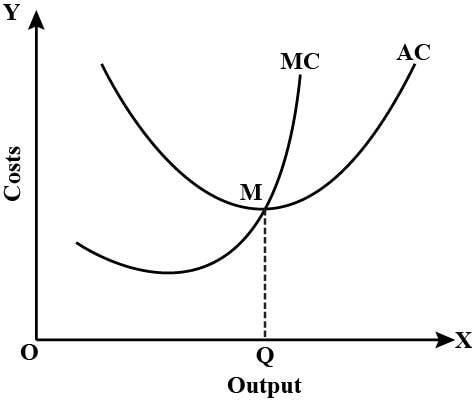CUET PG Economics Mock Test - 2 - CUET PG MCQ
30 Questions MCQ Test - CUET PG Economics Mock Test - 2
The existence of purchasing power parity in an open economy implies that
(A) The purchasing power of individuals depends on inflation rate
(B) The exchange rate between two countries' currency is equal to the ratio of their price levels
(C) Law of one price holds
(D) The price levels of all countries are equal when measured in terms of same currency
Choose the correct answer from the options given below:
(A) The purchasing power of individuals depends on inflation rate
(B) The exchange rate between two countries' currency is equal to the ratio of their price levels
(C) Law of one price holds
(D) The price levels of all countries are equal when measured in terms of same currency
Choose the correct answer from the options given below:
When the marginal cost is equal to average cost, the slope of the average cost is :
Which factor among the following creates problems while measuring the national income in India?
Calculate the weighted arithmetic mean of 10, 20 and 30, when the given weights are
(A) 3, 2 and 1 respectively
(B) 1, 1 and 3 respectively
(C) 1, 2 and 3 respectively
(D) 2, 1 and 2 respectively
Now arrange the answer in descending order.
List the following outcomes in descending order
(A) Probabilty of a head when one coin is tossed
(B) Probabiltiy of 5 heads when 10 coins are tossed independently
(C) Probability of 10 heads when 20 coins are tossed independently
(D) Probability of 50 heads when 100 coins are tossed independently
Choose the correct answer from the options given below:
Consider a binomial distribution with a very large N. This distribution can be approximated by:
In how many ways can 10 economists attending a conference be accomodated in 2 triple sharing and 2 double sharing hotel rooms?
Suppose X takes the values -10 and 20 with probability 1/4 and 3/4 respectively, calculate E(X2).
Match List-I with List-II
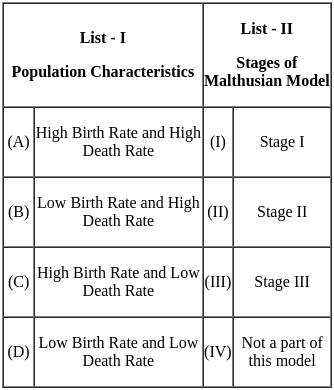
Choose the correct answer from the options given below:
Match the measures with the concept that is being measured.
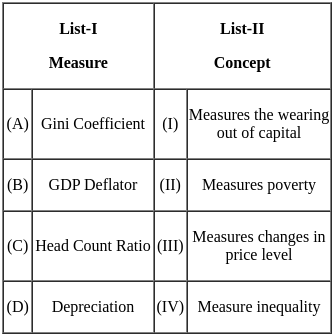
Choose the correct answer from the options given below:
When the substitution between factors of production is zero, the resultant isoquant is
Consider the following factors:
A. Deficit financing
B. Black money in an economy
C. High rate of population growth
Which of the factors given above are responsible for the demand-pull inflation in an economy?
Select the code for the correct answer from the options given below:
Human Development Index (HDI) is a measure that combines:
Which of the following statements correctly describes the crowding-out effect in the context of expansionary fiscal policy?
Match List-I with List-Il
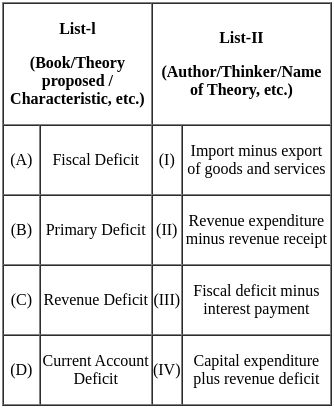
Choose the correct answer from the options given below:
A market in which there are large numbers of sellers of a particular product, but each seller sells somewhat differentiated but close products is termed as
Which of the following are instruments of trade policies?
(A) Tariffs
(B) Quotas
(C) Sales taxes
(D) Anti-dumping duties
Choose the correct answer from the options given below:
Suppose we have three coins. The first coin has heads on both sides. The second coin has tails on both sides. The third coin has head on one side and tail on second side. One coin is randomly selected and tossed. The upper side of this coin turns out to be a head. What is the probability that the other side of this coin is tail?
Arrange the followings in a correct order.
(A) Procurement of foodgrains by the food corporation of India.
(B) Production of foodgrains in the agricultural sector.
(C) Distribution of foodgrains through fair price shops.
(D) Minimum support prices for foodgrains are decided.
Choose the correct answer from the options given below:
Match List-I with List-ll
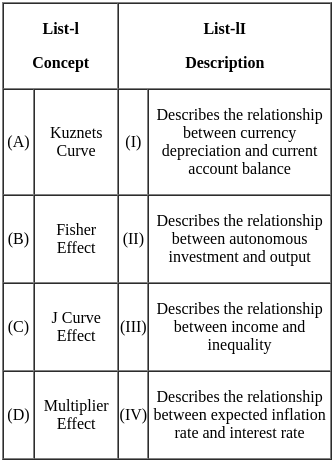
Choose the correct answer from the options given below:
Order the following country on the basis of nominal per capita income in year 2022, from the highest to lowest
(A) China
(B) Brazil
(C) Russia
(D) India
Choose the correct answer from the options given below:


